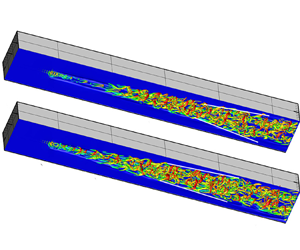Article contents
Transition induced by wall-normal vibration in flow around a flat plate with roughness
Published online by Cambridge University Press: 11 April 2022
Abstract

The effects of wall-normal vibration on bypass transition in a boundary-layer flow over a flat plate with roughness elements in the form of circular cylinders are investigated using direct numerical simulations (DNS), linear Floquet analyses and dynamic mode decompositions (DMD). The vibration of the plate strengthens the streamwise vorticity, consequently enhancing the velocity streaks and reducing the critical Reynolds number for transition. A map is constructed to identify the coupling effect of the vibration amplitude and Reynolds number on transition. Among all investigated combinations of height and diameter of roughness, the critical Reynolds numbers at different vibration amplitude  $A$ can be unified by a scaling function of
$A$ can be unified by a scaling function of  $(1-10A)$. Two instability modes are identified in the vibration-induced transition process: a wake mode immediately downstream of the roughness, related to the inviscid Kelvin–Helmholtz instability of the wall-normal shear in the wake; and a streak mode, in response to the spanwise shear of the streaky flow, occurring further downstream. The first one results in the generation of central hairpin vortices which then feed the second one. Further development of the streak instability leads to two arrays of hairpin vortices. Results from linear Floquet analyses and DMD further confirm the two modes of instability observed in DNS. A quantitative study suggests that the amplification of vibration-induced disturbance by the base shear dominates the production of streamwise vorticity and subsequently the hairpin vortices.
$(1-10A)$. Two instability modes are identified in the vibration-induced transition process: a wake mode immediately downstream of the roughness, related to the inviscid Kelvin–Helmholtz instability of the wall-normal shear in the wake; and a streak mode, in response to the spanwise shear of the streaky flow, occurring further downstream. The first one results in the generation of central hairpin vortices which then feed the second one. Further development of the streak instability leads to two arrays of hairpin vortices. Results from linear Floquet analyses and DMD further confirm the two modes of instability observed in DNS. A quantitative study suggests that the amplification of vibration-induced disturbance by the base shear dominates the production of streamwise vorticity and subsequently the hairpin vortices.
- Type
- JFM Papers
- Information
- Copyright
- © The Author(s), 2022. Published by Cambridge University Press
References
REFERENCES
- 4
- Cited by



